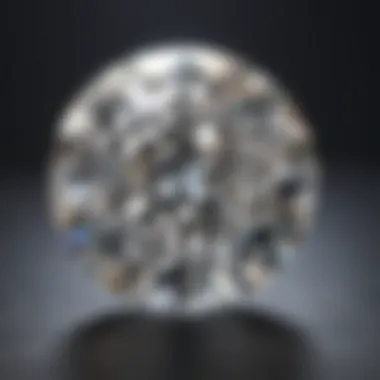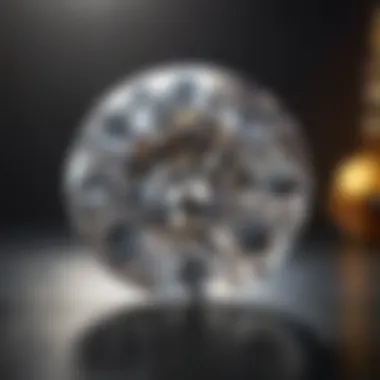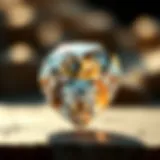Understanding the Importance of a 1 ct Diamond Solitaire


Intro
When we think of diamonds, the image that often lingers in our minds is that shimmering, intricately crafted piece of jewelry. Amid this grand tapestry of brilliance, the 1 ct diamond solitaire stands out prominently. This gem is more than just adornment; it’s a symbol steeped in cultural significance, emotional weight, and aesthetic allure. As we embark on an exploration of this particular diamond type, it's essential to grasp its essence and nuances, for every facet — from its characteristics to its sourcing — plays a role in understanding why a 1 ct diamond solitaire is cherished, desired, and celebrated.
Gemstone Overview
Definition and Characteristics
A 1 ct diamond solitaire generally refers to a diamond that weighs one carat, typically set alone in a jewelry piece, highlighting its singular beauty. At its core, a diamond is a crystalline form of carbon known for its unparalleled hardness and brilliance. The classification of diamonds often hinges on their clarity, color, cut, and carat weight – collectively known as the "Four Cs." In the case of a solitaire, each aspect is accentuated, as the sole gem in the design commands attention.
The clarity of a diamond impacts its transparency and glow; fewer inclusions usually mean a higher quality stone. Color ranges from colorless to shades of light yellow or brown, but a truly exceptional solitaire is clear like a mountain spring. The cut, which determines how well the diamond reflects light, is especially vital for a solitaire, as it directs the onlooker's gaze straight to its heart, showcasing its inner fire.
Classification of Gemstones
In the broader context, gemstones can be classified into several categories. Diamonds are generally termed precious stones, alongside sapphires, rubies, and emeralds. While this classification is traditional, emerging trends hint at a growing appreciation for semi-precious stones, which hold their unique charm and mystique. Like diamonds, these stones can also become pieces of a significant life narrative.
"Understanding a gemstone isn’t just about its physical beauty; it’s about the stories and feelings it evokes in us."
Properties of Gemstones
Physical Properties
Physical properties of diamonds contribute significantly to their desirability. Their exceptional hardness is unmatched, making them ideal for both daily wear in jewelry and practical applications like cutting tools. A diamond's superior durability lends itself well to preserving its timeless beauty against life's inevitable wear and tear.
Chemical Properties
Chemically, diamonds are composed purely of carbon atoms arranged in a crystal lattice. This unique structure provides the diamond not only with its remarkable strength but also its stunning optical properties. When light enters a diamond, it's refracted into a spectrum of colors, creating what’s known as brilliance. The high purity of a quality diamond further enhances its reflective properties, contributing to the love affair many have with this precious stone.
In a world where meaning is crafted not just from the tangible but also from the emotional resonance behind possessions, the 1 ct diamond solitaire stands at the crossroads of beauty, significance, and memory.
As we delve deeper into the cultural implications and real-world considerations related to purchasing such a gem, we will find it’s not simply about acquiring a sparkler; it’s about weaving narratives in life’s grand tapestry.
Prolusion to ct Diamond Solitaires
In the realm of luxurious adornments, the 1 ct diamond solitaire stands out not just as a piece of jewelry, but as a powerful symbol of commitment, elegance, and personal significance. This article delves into the essence of this precious gemstone configuration, exploring various facets that accentuate its importance.
One of the most compelling aspects of a 1 ct diamond solitaire is its balance. The carat weight denotes a substantial size that captures attention yet remains versatile for a range of settings. This harmony makes it a preferred choice for engagements, anniversaries, and other milestones. The rarity and value associated with a single-carat diamond further elevate its status, offering both emotional and financial investment.
Definition and Characteristics
A 1 ct diamond solitaire is defined by its singular, standout diamond, typically set in an elegant band. The term ‘solitaire’ derives from its display of a lone diamond, meant to draw focus. This simplicity speaks volumes, allowing the diamond's characteristics—such as cut, clarity, and color—to shine without distraction.
Diamonds are graded based on the four Cs: cut, color, clarity, and carat. When discussing a 1 ct diamond solitaire, each element contributes to its ultimate allure:
- Cut: The way a diamond is cut can affect its brilliance. A well-cut diamond will reflect light beautifully, creating a sparkle that captures the eye.
- Clarity: This defines how clear the diamond appears. Higher clarity means fewer imperfections, contributing to its stunning appearance.
- Color: Diamonds can range from colorless to shades of yellow or brown. A colorless diamond usually holds a higher value.
- Carat: Simply put, this measures the size of the diamond, with 1 ct being a significant size in the world of gemstones.
Together, these characteristics create a distinct personality for each diamond, making every solitaire unique.
Cultural Significance of Solitaires


The cultural weight behind a 1 ct diamond solitaire cannot be overstated. For many, it’s more than just a piece of jewelry—it’s an emblem of love, achievement, and promise. Historically, diamonds have been revered for their durability and brilliance, making them suitable markers for life’s most significant promises, such as engagements.
In contemporary culture, the diamond solitaire's significance has extended beyond mere romance. It reflects personal achievements and milestones, representing self-love and empowerment as individuals commemorate their journeys. Furthermore, this type of diamond piece often appears in traditional ceremonies across various cultures, embodying the union between partners and serving as a keepsake for generations.
The act of gifting a 1 ct diamond solitaire transmits emotions—be it love, friendship, or a celebratory milestone. Each piece carries a story, a moment frozen in time, making it infinitely more than just a sparkling stone.
In summary, understanding the definition and cultural significance of the 1 ct diamond solitaire provides insight into its lasting appeal. It transcends craftsmanship, merging individuality with shared experiences, ultimately signifying deep connections and memories.
Technical Aspects of a ct Diamond
The technical aspects of a 1 ct diamond play a crucial role in determining its overall quality and desirability. These attributes are not just mere numbers or grades but form the foundation upon which the beauty and allure of the diamond rests. Understanding these technicalities is vital for enthusiasts, collectors, and potential buyers who wish to make informed decisions. In essence, evaluating clarity, cut, color grading, and carat weight ensures that the selection aligns not only with aesthetic preferences but also with investment potential.
Clarity: Understanding Purity Levels
Clarity refers to the presence of internal flaws or external blemishes in a diamond. Diamonds are rarely perfect; however, the degree of clarity can significantly influence their beauty and market value. The GIA (Gemological Institute of America) assesses clarity on a scale from Flawless (no inclusions visible) to Included (inclusions obvious to the naked eye). Each classification reveals information crucial in understanding the jewel's worth.
Key points regarding clarity:
- Flawless diamonds are extremely rare and hold higher value.
- VS (Very Slightly Included) diamonds are often great choices as their inclusions are hard to spot without magnification.
- Enhance your knowledge by examining diamonds under different lighting conditions, as clarity can appear to shift, demonstrating how factors such as cut and polish interplay with purity.
Cut: The Importance of Facets
The cut of a diamond is fundamental to how light travels through it. Unlike other characteristics, the cut refers not to the shape, like round or princess, but to how well the diamond has been shaped and polished. A well-cut diamond can effuse brilliance and fire, while a poorly cut one may appear dull, regardless of its carat weight.
- Ideal Cut diamonds are designed to reflect maximum light, creating that sought-after sparkle.
- Angles and proportions play a significant role in the quality of the cut, where slight deviations can dramatically affect how light interacts with the stone.
- Diamonds cut with great precision demonstrate a high level of artisanship, which often appeals to buyers seeking a balance of beauty and craftsmanship.
Color Grading and Its Impact
Color grading in diamonds ranges from colorless (D) to light yellow or brown (Z). The more colorless a diamond is, the purer it appears and typically the more valuable it is considered. Color affects the perception and setting choice, as certain metals like white gold complement colorless stones better than warmer tones.
- Colorless diamonds often exhibit the best brilliance and fire, making them desirable.
- Many buyers prefer Near Colorless (G-H) diamonds since they offer a significant visual appeal while being budget-friendly compared to D-F options.
- Context matters, though; the surrounding metal and the diamond's cut can skew the color's perception.
Carat Weight: Rarity and Value
Carat weight signifies the weight of the diamond, with 1 carat equating to 200 milligrams. Many people think of carat weight as a sole measure of a stone's value, but in reality, it's just one piece of the puzzle. Larger diamonds are often rarer than smaller ones, leading to a dramatic spike in price.
- 1 ct diamonds strike a balance, being substantial enough to attract attention while still being accessible.
- Prices often increase exponentially at certain increments like 0.90 ct to 1 ct, highlighting the financial implications of carat weight.
- When selecting a diamond, consider how carat interacts with cut, clarity, and color, as combinations can yield far more attractive stones even at smaller weights.
"Understanding a diamond's technical attributes isn't just for the connoisseur; it empowers anyone looking to purchase with confidence and insight."
By digging into these technical aspects, buyers and enthusiasts alike can appreciate diamonds beyond their outward appearance, leading to more satisfying choices and investments in these timeless gems.
Selecting the Right ct Diamond Solitaire
When it comes to picking the ideal 1 ct diamond solitaire, the process can feel like navigating a minefield. It’s not just about wandering into a store and picking the prettiest sparkler. Rather, it’s a task that involves careful consideration of quality, ethical sourcing, and personal sentiment. This section sheds light on those aspects, making it easier for potential buyers to understand what they should prioritize in their selections.
Guidelines for Choosing Quality
Selecting a diamond is a journey rather than a sprint. The primary aspect one should look at is the Four Cs: clarity, cut, color, and carat weight. The quality of a diamond doesn’t just shine through in its look; it’s rooted in its characteristics.
- Clarity: This refers to the number of blemishes and inclusions within the diamond. A higher clarity grade typically equals a more valuable stone, though many buyers find beauty in lower clarity grades too.
- Cut: This is crucial, as it dictates how well the diamond reflects light. An expertly cut diamond will dazzle, while a poorly cut one can appear lifeless.
- Color: The less color in a diamond, the higher its value. However, some prefer the warm tones of light yellow diamonds, showing that personal taste plays a huge role.
- Carat Weight: The weight impacts value but remember, a beautifully cut lighter diamond can appear more striking than a heavier, poorly cut one.


Selecting a diamond goes beyond these technicalities. Consider the overall aesthetic appeal, the setting you choose, and the emotional significance behind the purchase. After all, a diamond is more than a financial investment; it's a keepsake, a symbol.
Evaluating Trusted Sources
With the ever-growing market of diamonds, understanding where to buy is essential. Not all jewelers are created equal. It's crucial to choose a reputable dealer who can guarantee the diamond's quality and ethical sourcing. This doesn’t just protect your investment; it assures peace of mind.
Start by looking into the jeweler’s background. Are they established? Do they have positive reviews? Online platforms can be a helpful resource. Websites like Reddit often have community discussions where you can read firsthand experiences from other buyers. Additionally, trusted jewelry associations or guilds can be indicators of reliability.
Consulting with friends and family who have recently made purchases can also guide you in selecting a reputable seller. Word of mouth holds a lot of weight in the jewelry industry.
Understanding Certification and Appraisals
One could argue that a diamond’s certificate is its passport. It provides vital information about the gem's quality. Before making a purchase, ensure that your stone comes with a grading report from a recognized gemological laboratory, such as the Gemological Institute of America (GIA).
- What to Look For: A grading report should detail the diamond's quality characteristics based on the Four Cs, confirming authenticity.
- Appraisals: Seeking an appraisal from a certified gemologist can further validate your gem's value, especially for insurance purposes. It's practically a safety net cover for such a significant investment.
While shopping for a 1 ct diamond solitaire, don’t forget the unique emotional tale behind it. It's about finding a gem that reflects not just personal taste, but shared memories, dreams, and milestones. A diamond should echo one's values, aesthetics, and in many ways, the journey of love.
"A diamond is forever, but the memories attached to it are what make it truly priceless."
By diving deeply into selection criteria, trusted sources, and certification processes, buyers can navigate this domain with confidence, ensuring that their choice aligns with their values and desires.
Whether you go for brilliance or warmth in color, remember that your choice is as much about personal resonance as it is about quality.
Caring for Your Diamond Solitaire
Caring for a diamond solitaire isn’t just a matter of aesthetics; it’s a commitment to preserving the memory and investment that this piece represents. Diamonds, while inherently tough, can be susceptible to damage if not attended to properly. Like a fine watch or an intricate piece of art, a diamond solitaire flourishes with the right care, providing both emotional and aesthetic rewards over time. The importance of proper maintenance and cleaning cannot be stressed enough, as these practices not only enhance the diamond's appearance but also protect its value.
Cleaning and Maintenance Techniques
Cleaning your diamond may seem straightforward, but a few essential techniques can markedly enhance its sparkle and longevity. Here are some effective strategies:
- Home Solutions: A mixture of warm water and mild dish soap can work wonders. Soak your ring for about 20 to 30 minutes, then gently brush with a soft toothbrush. This removes dirt and oils that may have accumulated, leaving your stone shining like new.
- Professional Cleanings: While routine home cleaning is beneficial, occasional visits to a professional jeweler can make a significant difference. Experts have the tools and know-how to access even the tightest of settings without compromising your diamond’s integrity.
- Avoid Harsh Chemicals: It's tempting to resort to powerful commercial cleaners, but they can damage the stone or the setting itself. Stick to gentle solutions to safeguard your solitaire's beauty.
"Regular cleaning amplifies not only the brilliance of your diamond but also its emotional connection to special moments in your life."
Safe Storage Solutions
When it comes to storing your diamond solitaire, a few practical considerations can help retain its beauty. An effective storage solution avoids scratches and weight from other jewelry that may hastily be tossed into the same box. Here are a few safe storage tips:
- Jewelry Box with Soft Linings: Use a jewelry box lined with soft fabric. Soft fabric helps prevent scratches and keeps the diamond in pristine condition.
- Individual Compartments: If possible, place your solitaire in a compartment dedicated solely to it, minimizing contact with other pieces.
- Avoid Humidity: Store your jewelry in a dry environment to prevent tarnishing of the metal settings.
To summarize, treating your diamond solitaire with care through regular cleaning and proper storage methods is crucial for maintaining its allure and emotional significance. After all, these diamonds often symbolize major life events or milestones, making their glow a representation of cherished memories.
Ethical Considerations in Diamond Sourcing
In the luxurious world of diamond solitaires, the beauty and brilliance are not the only elements that captivate potential buyers. Increasingly, consumers recognize the significance of ethical sourcing as a pivotal aspect of their purchasing decisions. In recent years, diamond sourcing has transitioned from being merely a process involving quality and aesthetics to one heavily infused with moral considerations. Understanding why these ethical concerns matter, particularly in connection with 1 ct diamond solitaires, educates buyers and fosters a more responsible market.
Understanding Conflict Diamonds


Conflict diamonds, often referred to as blood diamonds, are mined in war zones and sold to finance armed conflict against governments. The tragic irony is that while a diamond symbolizes love and commitment for many, some diamonds come with an entirely different emotional narrative—one tinged with suffering and exploitation.
This grim reality was brought to light in the late 1990s, which led to increased scrutiny on diamond trading. To address this, various initiatives like the Kimberley Process Certification Scheme were initiated. This process seeks to ensure that diamonds are sourced ethically, ensuring that no gems with a tainted history reach the market. However, critics argue that the effectiveness of such schemes is limited. Many still find ways to sidestep regulations, rendering some diamonds still conflict-laden.
To ensure that your 1 ct diamond solitaire is free from such associations, ask retailers about the origins of their stones and seek certifications that guarantee ethical sourcing. Understanding this facet helps buyers make more informed decisions, fostering a marketplace where all parties operate under strict ethical guidelines.
Sustainable Sourcing Practices
Sustainable sourcing practices have become the cornerstone of modern diamond procurement, emphasizing environmental and social responsibility. To some, a diamond is just a brilliant stone, but for others, it's a commitment to a sustainable future.
Sustainable diamond mining operates on a principle that seeks to minimize environmental impact while maximizing social benefits within mining communities. For example:
- Environmental Stewardship: Sustainable practices ensure that land is rehabilitated after mining activities. This minimizes long-term environmental damage and fosters ecosystems to flourish post-extraction.
- Supporting Local Communities: Many ethical diamond sources commit a portion of their proceeds to community development efforts. This can manifest in education programs, healthcare initiatives, and infrastructure improvements, directly benefiting those living within mining areas.
- Transparency in Operations: Buyers today demand clarity about product origins. Sustainable sourcing entails traceability, where each diamond's journey can be tracked from the ground to the retail display, affirming its ethical provenance.
"Choosing a diamond is not just about weight or cut, but also about its journey before it reaches your hand. Every choice makes a statement."
The Emotional Value of a ct Solitaire
Moments Associated with Diamond Gifts
The emotional weight of a diamond solitaire, especially one at the 1 ct mark, is often tied to the significant moments it celebrates. Imagine the scene: a softly lit evening, where the air buzzes with anticipation as someone kneels down, revealing a gorgeous 1 ct diamond solitaire. This moment is not just about the ring; it represents a culmination of feelings—love, commitment, and memories waiting to be forged.
Each diamond carries stories, memories that are personal and poignant, like a delightfully wrapped gift just waiting to be discovered. A 1 ct diamond solitaire becomes a tangible symbol of a shared history and the promise of a future, making the experience of gifting or receiving exceptionally profound. It marks milestones such as engagements and anniversaries, capturing the essence of love in its sparkle.
In this light, a diamond is not merely a gemstone; it is a vessel of cherished moments. The recipient may view it as a reminder not only of a commitment made but also of the adventure awaiting them. So, in terms of emotional value, it transcends the physical realm, embedding itself in the life story of the wearer.
Symbolism Beyond Aesthetics
- Eternal love: A diamond embodies an unbreakable bond. It reflects the notion that true love endures the tests of time, shining brighter as years pass.
- Commitment and promise: Gifting a 1 ct solitaire at a pivotal moment signifies a dedication to a shared path. It serves as a reminder of vows exchanged, often visually echoed in the cut and luster of the ring.
- Heritage and legacy: Beyond personal significance, diamonds have a way of becoming heirlooms. They often get passed down through generations, attaching stories of love, sacrifice, and family to their glimmer.
Ultimately, the 1 ct diamond solitaire becomes more than a piece of jewelry; it is a symbol—an artifact that conveys life's deepest feelings and connections. Its emotional value is woven into its very essence, bridging the gap between aesthetic appreciation and heartfelt recognition.
"A diamond's sparkle can fade, but the emotions tied to it can illuminate a lifetime."
Thus, when choosing a diamond solitaire, it's essential to reflect on its emotional implications. What moments do you wish to capture? What promises do you want to keep alive? The answers may very well enrich the significance of the diamond far beyond its physical attributes.
Culmination: The Timeless Appeal of ct Solitaires
A one-carat diamond solitaire holds a special place in the hearts of many. It is not merely a piece of jewelry but a symbol laden with meaning and emotion. This section focuses on why the 1 ct solitaire continues to resonate with people across generations.
Reflection on the Longevity of Diamonds
Diamonds are more than an investment. Their durability and rarity have solidified their role as timeless treasures. Unlike other gemstones, diamonds are renowned for their hardness and resistance to scratching. This enduring characteristic ensures that a well-cared-for diamond can last a lifetime, often passed down through families.
The history of diamonds can be traced back for centuries, serving as indicators of wealth and status. Interestingly, the fascination with diamonds has evolved, blending luxury with sentiment. A 1 ct diamond solitaire, for instance, can mark significant life milestones, from engagements to anniversaries.
"A diamond is forever." This saying encapsulates not only the strength of the stone but also its emotional significance. When one exchanges a diamond ring, they are also exchanging promises and commitments, etching memories into the fabric of one’s life.
Future of Diamond Industry Trends
As the landscape of jewelry evolves, so too does the diamond industry. Trends are shifting towards more sustainable practices, including ethically sourced diamonds. Many consumers now prioritize ethical considerations when purchasing diamonds. They seek transparency about their origins and the mining processes involved.
Technological advancements, such as lab-grown diamonds, have also made headlines. These diamonds boast the same chemical properties as natural stones but typically at a lower cost. The growing acceptance of lab-created diamonds is likely to change perceptions and accessibility.
Moreover, the trend of customization has gained traction. Buyers are increasingly interested in unique designs and personal touches when it comes to their diamond solitaire. With many options available, each piece tells a story, making it a gift that transcends mere aesthetics
In summary, while the 1 ct diamond solitaire remains a classic, its appeal lies in its adaptability to modern values, especially those concerning sustainability and personalization. Whether as a symbol of love or a celebration of self, the 1 ct solitaire continues to shine in a world that is forever changing.



